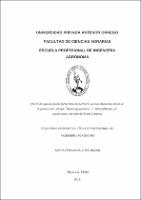Mostrar el registro sencillo del ítem
Efecto de aplicación del biofertilizante Avibiol en tres diferentes dosis en la producción del apio Apium graveolens L. (Umbeliferae), en condiciones del Valle de Santa Catalina
| dc.contributor.advisor | Pereda Paredes, Alvaro Hugo | |
| dc.contributor.author | Vites Bazan, Maria Fernanda | |
| dc.creator | Vites Bazan, Maria Fernanda | |
| dc.date.accessioned | 2018-05-11T22:47:59Z | |
| dc.date.available | 2018-05-11T22:47:59Z | |
| dc.date.issued | 2018 | |
| dc.identifier.uri | https://hdl.handle.net/20.500.12759/4108 | |
| dc.description.abstract | El presente trabajo de investigación se desarrolló en el Campus II de la Universidad Privada Antenor Orrego de Trujillo, situado en el distrito de Laredo en la localidad de Nuevo Barraza con el objeto de determinar el efecto de aplicación del Biofertilizante AVIBIOL en tres diferentes dosis en la producción del apio (Apium graveolens L), en condiciones del valle de Santa Catalina. El diseño experimental utilizado fue de Bloques Completamente al Azar, con cuatro tratamientos 0, 160, 180, 200 litros del Biofertilizante AVIBIOL por hectárea y cuatro repeticiones. Las aplicaciones se realizaron en forma foliar y en dos oportunidades con quince días de intervalo entre aplicaciones y veinte días después del trasplante, las plagas y enfermedades que se presentaron fueron controlados oportunamente y haciendo labores de control cultural, etológico y químico. Realizado el trabajo de campo se observó que es el tratamiento 3 el que consigue los mayores resultados así tenemos que logra la mayor altura de planta con 51.75 cm mientras que el tratamiento 1 o testigo sin aplicación 45.25 y 43.50 cm respectivamente, es decir un promedio de 7.38 cm menos. Igualmente en lo que respecta al diámetro de planta es en el tratamiento 3 (200 L/ha) el que logra el mayor índice con 69.26 mm, es decir 7.1 mm más que el tratamiento 1 y el Testigo sin aplicación. | es_PE |
| dc.description.abstract | The present research work was developed in Campus II of the Antenor Orrego Private University of Trujillo located in the district of Laredo in the town of Nuevo Barraza in order to determine the effect of application of the Biofertilizer AVIBIOL in three different doses in the production of celery (Apium graveolens L.), in conditions of the Santa Catalina valley. The experimental design used was of Completely Random Blocks, with four treatments 0, 160, 180, 200 liters of Biofertilizer AVIBIOL per hectare and four repetitions. The applications were made in foliar form and on two occasions with fifteen days of interval between applications and twenty days after the transplant, the plagues and diseases that were presented were controlled in a timely manner and doing cultural, ethological and chemical control tasks. Once the field work was carried out, it was observed that treatment 3 achieved the highest results, thus achieving the highest plant height with 51.75 cm while treatment 1 or control without application 45.25 and 43.50 cm respectively, that is, an average of 7.38 cm shorter. Equally as regards the diameter of the plant, it is in treatment 3 (200 L / ha) that it achieves the highest index with 69.26 mm, that is, 7.1 mm more than treatment 1 and the control without application. | en_US |
| dc.description.uri | Tesis | es_PE |
| dc.format | application/pdf | es_PE |
| dc.language.iso | spa | es_PE |
| dc.publisher | Universidad Privada Antenor Orrego - UPAO | es_PE |
| dc.relation.ispartofseries | T_ING.AGRON_489 | |
| dc.rights | info:eu-repo/semantics/openAccess | es_PE |
| dc.source | Universidad Privada Antenor Orrego | es_PE |
| dc.source | Repositorio Institucional - UPAO | es_PE |
| dc.subject | Biofertilizante | es_PE |
| dc.subject | Valle Santa Catalina | es_PE |
| dc.title | Efecto de aplicación del biofertilizante Avibiol en tres diferentes dosis en la producción del apio Apium graveolens L. (Umbeliferae), en condiciones del Valle de Santa Catalina | es_PE |
| dc.type | info:eu-repo/semantics/bachelorThesis | es_PE |
| thesis.degree.level | Título Profesional | es_PE |
| thesis.degree.grantor | Universidad Privada Antenor Orrego. Facultad de Ciencias Agrarias | es_PE |
| thesis.degree.name | Ingeniero Agrónomo | es_PE |
| thesis.degree.discipline | Ingeniería Agrónoma | es_PE |
Ficheros en el ítem
Este ítem aparece en la(s) siguiente(s) colección(es)
-
Ingeniería Agrónoma [93]

